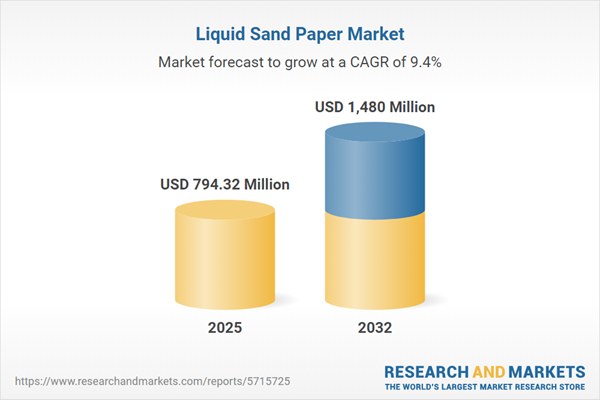Speak directly to the analyst to clarify any post sales queries you may have.
The liquid sand paper market is transforming as organizations demand more streamlined surface preparation, regulatory compliance, and innovations in formulation and application. Senior leaders must balance operational shifts, technology adoption, and ongoing efficiency to secure market position.
Market Snapshot: Liquid Sand Paper Market Size and Growth
The global liquid sand paper market continues to register strong growth. In 2024, the market value is reported at USD 727.39 million. This is expected to rise to USD 794.32 million in 2025. Such expansion reflects the collective investments made by manufacturing, construction, automotive, and marine sectors as they seek advanced surface treatment solutions. Growth is supported by a steady CAGR of 9.35%, highlighting how industry participants adapt to evolving customer requirements and updated manufacturing practices. In the long term, projections place the market value at USD 1.48 billion by 2032, demonstrating sustained momentum due to ongoing developments in regulatory adaptation, process reliability, and productivity enhancements across critical applications.
Scope & Segmentation: Comprehensive Market Overview
This report delivers a granular breakdown of the liquid sand paper market to equip decision-makers with actionable insights. A clear view of key segments and strategic drivers enables organizations to align operational, procurement, and technology strategies effectively:
- Applications: Automotive refinishing, construction substrates, marine maintenance, metalworking, and woodworking are addressed, each presenting distinct surface requirements and adaptation needs.
- End Use Industries: Examines commercial, industrial, and residential sectors, reflecting how criteria and expectations shape product selection and procurement strategies.
- Types: Covers both aerosol and direct liquid formats, meeting the needs of manual workflows and automated systems in organizations with diverse technology maturity.
- Formulations: Includes solvent-based and water-based options, which play a crucial role in driving operational efficiency and supporting environmental standards compliance.
- Grit Levels: Details coarse, medium, and fine selections designed to deliver compliant finishes and workplace safety across applications.
- Distribution Channels: Features direct distributors, hypermarkets, specialty retailers, proprietary online stores, e-commerce partners, general online marketplaces, and industrial supply channels, ensuring access for every buyer profile.
- Regions and Key Countries: Focuses on North America, South America, Europe, Middle East & Africa, and Asia-Pacific, calling attention to key markets such as the United States, China, Germany, United Kingdom, and India for tailored regional planning.
- Company Profiles: Highlights leading names like The Sherwin-Williams Company, PPG Industries, Nippon Paint Holdings, Akzo Nobel, RPM International, Axalta Coating Systems, BASF SE, Kansai Paint, Hempel, and Jotun, offering critical benchmarks for innovation and partnership exploration.
Key Takeaways for Senior Decision-Makers
- Advanced abrasive formulations and liquid dispersal technology are improving surface durability, equipment longevity, and overall process uptime.
- Increasing regulatory scrutiny drives adoption of water-based solutions, influencing procurement and supply chain strategies to align with environmental mandates.
- Adoption of automation and digital controls in manufacturing enhances process consistency and enables better predictive maintenance and production oversight.
- The presence of robust omnichannel distribution ensures flexibility in procurement and supports preparedness against supply chain volatility.
- Collaborative partnerships between manufacturers and suppliers are enabling tailored solutions for volume production and specialty retail customers.
- Custom surface finish preferences in sectors such as automotive and furniture are spurring innovation, enabling differentiation in mature markets.
Tariff Impact: Navigating New U.S. Trade Barriers
Forthcoming U.S. tariffs expected in 2025 will require revisions to sourcing and procurement strategies for liquid sand paper. Companies are advised to enhance domestic manufacturing capabilities, broaden their supplier base, and adjust product lines to manage compliance and pricing stability. Optimized inventory management and the forging of local partnerships are essential for maintaining competitive advantage during shifts in trade policy.
Methodology & Data Sources
This report draws on secondary research, interviews with relevant industry stakeholders, and targeted surveys. Data accuracy and insight are reinforced using triangulation, robust modeling, and evaluation through frameworks like SWOT and PESTEL analysis.
Why This Report Matters
- Enables precise segmentation and geographic planning to support effective decision-making across procurement, sourcing, and operations.
- Clarifies the effect of emerging technologies and compliance trends, preparing leaders to navigate evolving organizational challenges.
- Delivers actionable guidance for risk mitigation in response to tariff and trade developments, reinforcing supply chain resilience.
Conclusion
Companies that prioritize agile sourcing and integrated, responsive solutions are best positioned to succeed as the liquid sand paper market adapts to ongoing shifts in regulation, technology, and end-user requirements.
Additional Product Information:
- Purchase of this report includes 1 year online access with quarterly updates.
- This report can be updated on request. Please contact our Customer Experience team using the Ask a Question widget on our website.
Table of Contents
3. Executive Summary
4. Market Overview
7. Cumulative Impact of Artificial Intelligence 2025
List of Figures
Samples

LOADING...
Companies Mentioned
The key companies profiled in this Liquid Sand Paper market report include:- The Sherwin-Williams Company
- PPG Industries, Inc.
- Nippon Paint Holdings Co., Ltd.
- Akzo Nobel N.V.
- RPM International Inc.
- Axalta Coating Systems Ltd.
- BASF SE
- Kansai Paint Co., Ltd.
- Hempel A/S
- Jotun A/S
Table Information
| Report Attribute | Details |
|---|---|
| No. of Pages | 191 |
| Published | October 2025 |
| Forecast Period | 2025 - 2032 |
| Estimated Market Value ( USD | $ 794.32 Million |
| Forecasted Market Value ( USD | $ 1480 Million |
| Compound Annual Growth Rate | 9.3% |
| Regions Covered | Global |
| No. of Companies Mentioned | 11 |









